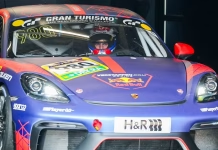Have you ever wondered if a small adjustment in your sim racing setup could be the key to shaving off those crucial seconds? Today, we’re delving into a question that echoes through the virtual racing engineering community: Does tweaking the ride height really change the grip?
Before we dive into the details, in all the sims, ride height is a setup basic component. Picture it as the unsung hero of your setup, silently influencing how your virtual machine hugs the corners. Now, let’s break down the science behind it without delving into rocket science.
How Ride Height Works
When you fiddle with the ride height, you’re essentially tweaking something called the roll center. Imagine it as the invisible point where your virtual car’s body and suspension pivot during a turn. Now, here comes the magic: lowering the front roll center alters how lateral forces move through your setup.
Let’s get hands-on.
Grab your steering wheel, fire up your favorite sim. Load up any setup and note down the total weight on the front left and right corners. Now, play with the ride height. Raise it, lower it—get a little wild. Did you notice any meaningful change in axle weight?
The Roll Center’s Impact on Grip
Here’s the revelation: lowering the front roll center sends more lateral force through the front springs and dampers, less through the linkages.
Translation: the front gets softer, offering more grip, but beware, this might come at the expense of the rear. It’s a delicate balance, and understanding this can be your ticket to a setup that dances elegantly on the track.
Physics Made Simple
Now, let’s take a quick detour into physics land. Picture those forces during a corner. Springs and dampers compress, but linkages, like control arms, don’t budge much. Lowering the roll center means more force through the spring, less through the linkage, resulting in, you guessed it, more grip.
The Dance of Trade-offs
But, and there’s always a ‘but’ in the world of setup tweaking, it’s not a universal remedy. Lowering the center of gravity is generally a good thing, and sometimes it widens the track for stability. However, consider ground clearance, suspension travel, and the aerodynamic impact. It’s a nuanced dance, a trade-off between gaining grip and maintaining other crucial aspects of your setup.
See you on the track!
This website uses affiliate links which may earn a commission at no additional cost to you.













